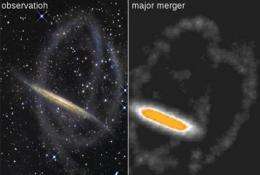The Dragon clash

NGC 5907 is a spiral galaxy lying in the Dragon constellation, showing extraordinary large loops and currents of stars in its surrounding halo. According to researchers, it could have been formed through a gigantic collision of galaxies, 8 to 9 billion years ago. Six scientists of the Observatoire de Paris, CNRS, Chinese Academy of Sciences, National Astronomical Observatories of China and Aix-Marseille Universite propose this scenario on the basis of simulations with 200 000 to 6 million particles. These up-to-date calculations, that include gas hydrodynamics, are able to reproduce in a film the formation of NGC5907 and its surrounding gigantic loops of matter. Results appeared on the cover of the online edition of Astronomy and Astrophysics, the 13 February 2012. They provide an important test for cosmological scenarios.
Numerous collisions have probably affected the shape of galaxies, and perhaps, half of spiral galaxies have been formed this way during the last 9 billions years. Possibly this is the case for NGC5907, a spiral galaxy in the Dragon constellation. However this galaxy is almost bulgeless, while prominent and classical bulges are generally considered to be a signature of major mergers.
In fact NGC5907 has been observed with the deepest ever-made imagery, revealing a system of stellar currents forming gigantic loops in its surrounding halo. These phenomena have been intensively studied by a team of six scientists of the Observatoire de Paris, CNRS, Chinese Academy of Sciences, National Astronomical Observatories of China NAOC and Marseille Observatory. To reproduce them they have used several state of the art, hydrodynamical, and numerical simulations with particle numbers ranging from 200 000 to 6 millions. They succeeded in doing so after assuming that these gigantic loops were the relic of a gigantic collision between galaxies of similar sizes, which would have occurred 8 to 9 billion years ago.
Previously the 150 000 light-years loops surrounding NGC5907 were believed to be associated to the capture of a very small satellite that would have lost its matter relatively recently. New simulations are excluding satellite masses that would be below one twelfth of the main galaxy. It also implies that the progenitors of NGC5907 and its loops were very gas rich, at least with gas fraction of 60%. Interestingly the new scenario can be easily falsified, as it predicts the presence of other, even larger but fainter, loops that could be observed in the near future. Already the new Chinese year appears to be fruitful for the French-Chinese collaboration, and possibly this year will see an interesting confirmation of what is the best scenario for making large spiral galaxies.
Numerical simulations have been made using 32- and 196-core computers at the Paris Observatory center and the 680-core Graphic Processor Unit supercomputer of Beijing NAOC with the capability to run 50000 billion operations per second. The smoothed particle hydrodynamical treeSPH code GADGET2 is a free software to which has been implemented a full description of star formation and all cooling and other physical processes.
More information: Loops formed by tidal tails as fossil records of a major merger, published February 13th, 2012 on Astronomy and Astrophysics online edition. www.aanda.org/10.1051/0004-6361/201117423
Provided by CNRS
















